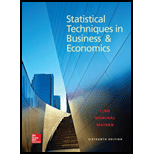
Refer to the Real Estate data, which report information on homes sold in Goodyear, Arizona, and the surrounding area last year.
- a. Determine the proportion of homes that have an attached garage. At the .05 significance level, can we conclude that more than 60% of the homes sold in the Goodyear, Arizona, area had an attached garage? What is the p-value?
- b. Determine the proportion of homes that have a pool. At the .05 significance level, can we conclude that more than 60% of the homes sold in the Goodyear, Arizona, area had a pool? What is the p-value?
- c. Develop a
contingency table that shows whether a home has a pool and the township in which the house is located. Is there an association between the variables pool and township? Use the .05 significance level. - d. Develop a contingency table that shows whether a home has an attached garage and the township in which the home is located. Is there an association between the variables attached garage and township? Use the .05 significance level.
a.
Find the proportion of homes that have an attached garage.
Check whether people can conclude that more than 60% of the homes have an attached garage.
Find the p-value.
Answer to Problem 62DE
The proportion of homes that have an attached garage is 0.6762.
It cannot be concluded that more than 60% of the homes have an attached garage.
The p-value is 0.056.
Explanation of Solution
Let
The proportion of homes that have an attached garage is obtained as follows:
Thus, the proportion of homes that have an attached garage is 0.6762.
The sample size n is 100 and
Step-by-step procedure to find the test statistic using MINITAB software:
- Choose Stat > Basic Statistics > 1 Proportion.
- Choose Summarized data.
- In Number of events, enter 71. In Number of trials, enter 105.
- Enter Hypothesized proportion as 0.60.
- Check Options, enter Confidence level as 95.0.
- Choose greater than in alternative.
- Select Method as Normal approximation.
- Click OK in all dialogue boxes.
Output is obtained as follows:
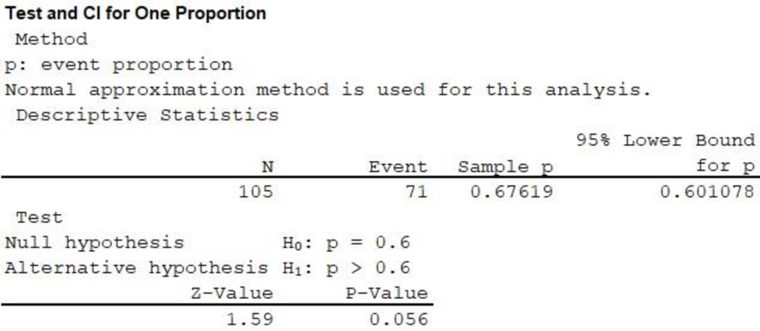
Thus, the value of the test statistic is 1.59 and the p-value is 0.056.
Decision rule:
If the p-value is less than the significance level, reject the null. Otherwise fail to reject the null hypothesis.
Conclusion:
The significance level is 0.05 and the p-value is 0.056.
Here, the p-value is greater than the significance level 0.05. By the rejection rule, fail to reject the null hypothesis.
Therefore, one cannot conclude that more than 60% of the homes have an attached garage.
b.
Find the proportion of homes that have a pool.
Check whether people can conclude that more than 60% of the homes have a pool.
Find the p-value.
Answer to Problem 62DE
The proportion of homes that have an attached garage is 0.6380.
It cannot be concluded that more than 60% of the homes have a pool.
The p-value is 0.213.
Explanation of Solution
Let
The proportion of homes that have a pool is obtained as follows:
Thus, the proportion of homes that have an attached garage is 0.6380.
Step-by-step procedure to find the test statistic using MINITAB software:
- Choose Stat > Basic Statistics > 1 Proportion.
- Choose Summarized data.
- In Number of events, enter 67. In Number of trials, enter 105.
- Enter Hypothesized proportion as 0.60.
- Check Options, enter Confidence level as 95.0.
- Choose greater than in alternative.
- Select Method as Normal approximation.
- Click OK in all dialogue boxes.
Output is obtained as follows:
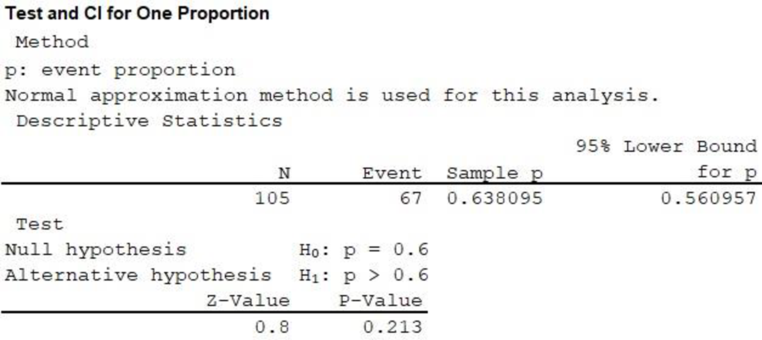
Thus, the value of the test statistic is 0.80 and the p-value is 0.213.
Conclusion:
The significance level is 0.05 and the p-value is 0.213. Here, the p-value is greater than the significance level 0.05. By the rejection rule, fail to reject the null hypothesis.
Therefore, one cannot conclude that more than 60% of the homes have a pool.
c.
Develop a contingency table that shows whether a home has a pool and the township in which the house is located.
Check whether there is an association between the variables pool and township.
Answer to Problem 62DE
There is no association between pool and township.
Explanation of Solution
From the given information, the contingency table that shows whether a home has a pool and the township in which the house is located is shown below:
| Pool | Township | |||||
| 1 | 2 | 3 | 4 | 5 | Total | |
| No | 9 | 8 | 7 | 11 | 3 | 38 |
| Yes | 6 | 12 | 18 | 18 | 13 | 67 |
| Total | 15 | 20 | 25 | 29 | 16 | 105 |
The null and alternative hypotheses are stated below:
The number of degrees of freedom for a contingency table is obtained as follows:
Therefore, the number of degrees of freedom is 4.
Step-by-step procedure to find the test statistic using MINITAB software:
- Choose Stat > Tables > Chi-Square Test for Association.
- Choose Summarized data in a two-way table.
- In Columns containing the table, enter the columns of 1, 2, 3, 4 and 5.
- In Rows enter Pool, in the columns, enter Township.
- Click OK.
Output is obtained using MINITAB is as follows:
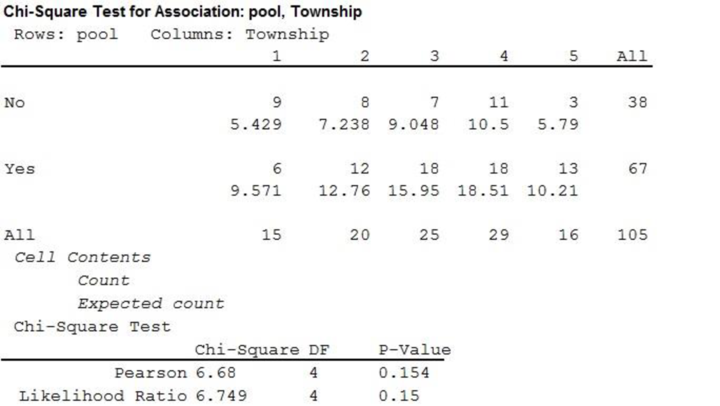
From the above output, the value of the test statistic is 6.68 and the p-value is 0.154.
Conclusion:
The significance level is 0.05 and the p-value is 0.154.
Here, the p-value is greater than the significance level 0.05. By the rejection rule, fail to reject the null hypothesis.
Thus, there is no association between pool and township.
d.
Develop a contingency table that shows whether a home has an attached garage and the township in which the house is located.
Check whether there is an association between the variables attached garage and township.
Answer to Problem 62DE
There is no association between garage and township.
Explanation of Solution
From the given information, the contingency table that shows whether a home has an attached garage and the township in which the house is located is shown below:
| Garage | Township | |||||
| 1 | 2 | 3 | 4 | 5 | Total | |
| No | 6 | 5 | 10 | 9 | 4 | 34 |
| Yes | 9 | 15 | 15 | 20 | 12 | 71 |
| Total | 15 | 20 | 25 | 29 | 16 | 105 |
The null and alternative hypotheses are stated below:
The number of degrees of freedom is obtained as follows:
Therefore, the number of degrees of freedom is 4.
Step-by-step procedure to find the test statistic using MINITAB software:
- Choose Stat > Tables > Chi-Square Test for Association.
- Choose Summarized data in a two-way table.
- In Columns containing the table, enter the columns of 1, 2, 3, 4 and 5.
- In Rows enter Garage, in the columns, enter Township.
- Click OK.
Output is obtained using MINITAB is as follows:
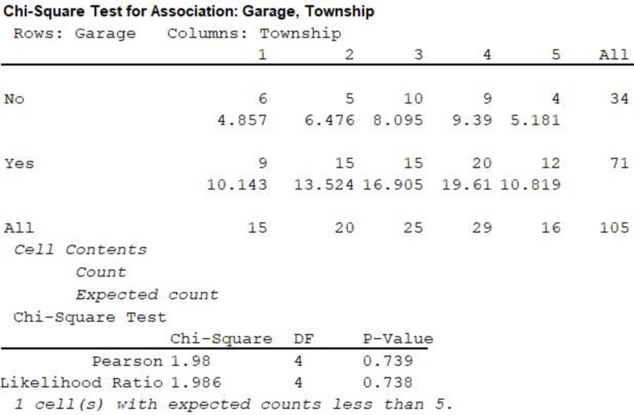
From the above output, the value of the test statistic is 1.98 and the p-value is 0.739.
Conclusion:
The significance level is 0.05 and the p-value is 0.739.
Here, the p-value is greater than the significance level 0.05. By the rejection rule, fail to reject the null hypothesis.
Thus, there is no association between garage and township.
Want to see more full solutions like this?
Chapter 15 Solutions
Loose Leaf for Statistical Techniques in Business and Economics (Mcgraw-hill/Irwin Series in Operations and Decision Sciences)
- Faye cuts the sandwich in two fair shares to her. What is the first half s1arrow_forwardQuestion 2. An American option on a stock has payoff given by F = f(St) when it is exercised at time t. We know that the function f is convex. A person claims that because of convexity, it is optimal to exercise at expiration T. Do you agree with them?arrow_forwardQuestion 4. We consider a CRR model with So == 5 and up and down factors u = 1.03 and d = 0.96. We consider the interest rate r = 4% (over one period). Is this a suitable CRR model? (Explain your answer.)arrow_forward
- Question 3. We want to price a put option with strike price K and expiration T. Two financial advisors estimate the parameters with two different statistical methods: they obtain the same return rate μ, the same volatility σ, but the first advisor has interest r₁ and the second advisor has interest rate r2 (r1>r2). They both use a CRR model with the same number of periods to price the option. Which advisor will get the larger price? (Explain your answer.)arrow_forwardQuestion 5. We consider a put option with strike price K and expiration T. This option is priced using a 1-period CRR model. We consider r > 0, and σ > 0 very large. What is the approximate price of the option? In other words, what is the limit of the price of the option as σ∞. (Briefly justify your answer.)arrow_forwardQuestion 6. You collect daily data for the stock of a company Z over the past 4 months (i.e. 80 days) and calculate the log-returns (yk)/(-1. You want to build a CRR model for the evolution of the stock. The expected value and standard deviation of the log-returns are y = 0.06 and Sy 0.1. The money market interest rate is r = 0.04. Determine the risk-neutral probability of the model.arrow_forward
- Several markets (Japan, Switzerland) introduced negative interest rates on their money market. In this problem, we will consider an annual interest rate r < 0. We consider a stock modeled by an N-period CRR model where each period is 1 year (At = 1) and the up and down factors are u and d. (a) We consider an American put option with strike price K and expiration T. Prove that if <0, the optimal strategy is to wait until expiration T to exercise.arrow_forwardWe consider an N-period CRR model where each period is 1 year (At = 1), the up factor is u = 0.1, the down factor is d = e−0.3 and r = 0. We remind you that in the CRR model, the stock price at time tn is modeled (under P) by Sta = So exp (μtn + σ√AtZn), where (Zn) is a simple symmetric random walk. (a) Find the parameters μ and σ for the CRR model described above. (b) Find P Ste So 55/50 € > 1). StN (c) Find lim P 804-N (d) Determine q. (You can use e- 1 x.) Ste (e) Find Q So (f) Find lim Q 004-N StN Soarrow_forwardIn this problem, we consider a 3-period stock market model with evolution given in Fig. 1 below. Each period corresponds to one year. The interest rate is r = 0%. 16 22 28 12 16 12 8 4 2 time Figure 1: Stock evolution for Problem 1. (a) A colleague notices that in the model above, a movement up-down leads to the same value as a movement down-up. He concludes that the model is a CRR model. Is your colleague correct? (Explain your answer.) (b) We consider a European put with strike price K = 10 and expiration T = 3 years. Find the price of this option at time 0. Provide the replicating portfolio for the first period. (c) In addition to the call above, we also consider a European call with strike price K = 10 and expiration T = 3 years. Which one has the highest price? (It is not necessary to provide the price of the call.) (d) We now assume a yearly interest rate r = 25%. We consider a Bermudan put option with strike price K = 10. It works like a standard put, but you can exercise it…arrow_forward
- In this problem, we consider a 2-period stock market model with evolution given in Fig. 1 below. Each period corresponds to one year (At = 1). The yearly interest rate is r = 1/3 = 33%. This model is a CRR model. 25 15 9 10 6 4 time Figure 1: Stock evolution for Problem 1. (a) Find the values of up and down factors u and d, and the risk-neutral probability q. (b) We consider a European put with strike price K the price of this option at time 0. == 16 and expiration T = 2 years. Find (c) Provide the number of shares of stock that the replicating portfolio contains at each pos- sible position. (d) You find this option available on the market for $2. What do you do? (Short answer.) (e) We consider an American put with strike price K = 16 and expiration T = 2 years. Find the price of this option at time 0 and describe the optimal exercising strategy. (f) We consider an American call with strike price K ○ = 16 and expiration T = 2 years. Find the price of this option at time 0 and describe…arrow_forward2.2, 13.2-13.3) question: 5 point(s) possible ubmit test The accompanying table contains the data for the amounts (in oz) in cans of a certain soda. The cans are labeled to indicate that the contents are 20 oz of soda. Use the sign test and 0.05 significance level to test the claim that cans of this soda are filled so that the median amount is 20 oz. If the median is not 20 oz, are consumers being cheated? Click the icon to view the data. What are the null and alternative hypotheses? OA. Ho: Medi More Info H₁: Medi OC. Ho: Medi H₁: Medi Volume (in ounces) 20.3 20.1 20.4 Find the test stat 20.1 20.5 20.1 20.1 19.9 20.1 Test statistic = 20.2 20.3 20.3 20.1 20.4 20.5 Find the P-value 19.7 20.2 20.4 20.1 20.2 20.2 P-value= (R 19.9 20.1 20.5 20.4 20.1 20.4 Determine the p 20.1 20.3 20.4 20.2 20.3 20.4 Since the P-valu 19.9 20.2 19.9 Print Done 20 oz 20 oz 20 oz 20 oz ce that the consumers are being cheated.arrow_forwardT Teenage obesity (O), and weekly fast-food meals (F), among some selected Mississippi teenagers are: Name Obesity (lbs) # of Fast-foods per week Josh 185 10 Karl 172 8 Terry 168 9 Kamie Andy 204 154 12 6 (a) Compute the variance of Obesity, s²o, and the variance of fast-food meals, s², of this data. [Must show full work]. (b) Compute the Correlation Coefficient between O and F. [Must show full work]. (c) Find the Coefficient of Determination between O and F. [Must show full work]. (d) Obtain the Regression equation of this data. [Must show full work]. (e) Interpret your answers in (b), (c), and (d). (Full explanations required). Edit View Insert Format Tools Tablearrow_forward
 Glencoe Algebra 1, Student Edition, 9780079039897...AlgebraISBN:9780079039897Author:CarterPublisher:McGraw Hill
Glencoe Algebra 1, Student Edition, 9780079039897...AlgebraISBN:9780079039897Author:CarterPublisher:McGraw Hill Holt Mcdougal Larson Pre-algebra: Student Edition...AlgebraISBN:9780547587776Author:HOLT MCDOUGALPublisher:HOLT MCDOUGAL
Holt Mcdougal Larson Pre-algebra: Student Edition...AlgebraISBN:9780547587776Author:HOLT MCDOUGALPublisher:HOLT MCDOUGAL Big Ideas Math A Bridge To Success Algebra 1: Stu...AlgebraISBN:9781680331141Author:HOUGHTON MIFFLIN HARCOURTPublisher:Houghton Mifflin Harcourt
Big Ideas Math A Bridge To Success Algebra 1: Stu...AlgebraISBN:9781680331141Author:HOUGHTON MIFFLIN HARCOURTPublisher:Houghton Mifflin Harcourt College Algebra (MindTap Course List)AlgebraISBN:9781305652231Author:R. David Gustafson, Jeff HughesPublisher:Cengage Learning
College Algebra (MindTap Course List)AlgebraISBN:9781305652231Author:R. David Gustafson, Jeff HughesPublisher:Cengage Learning




